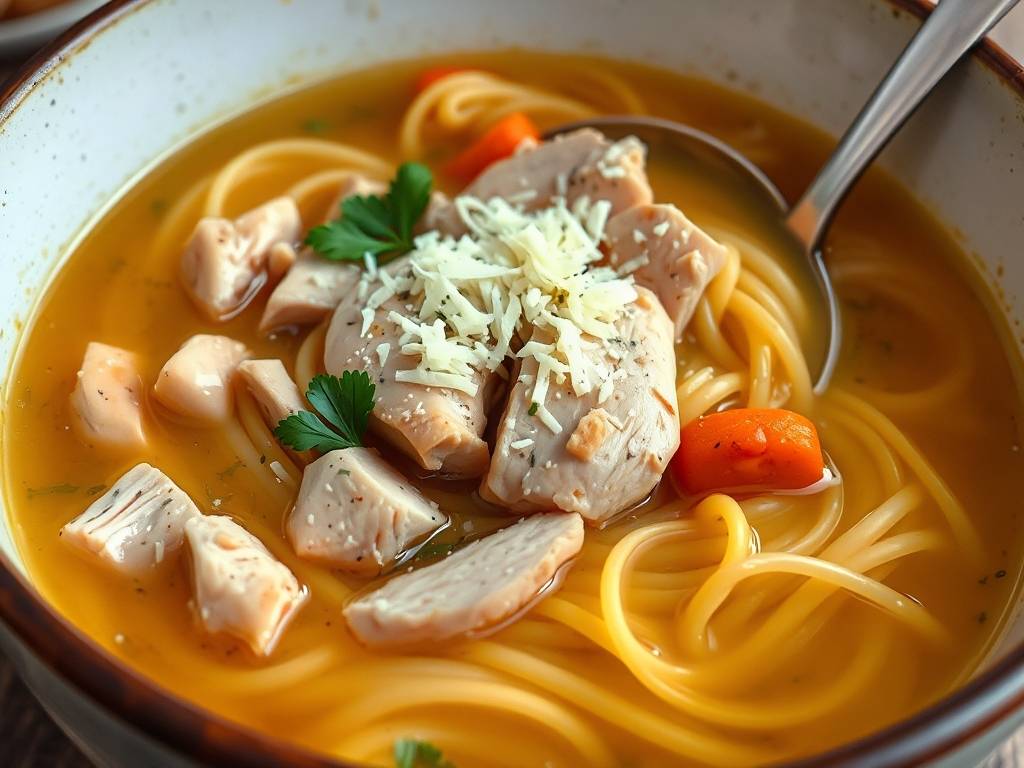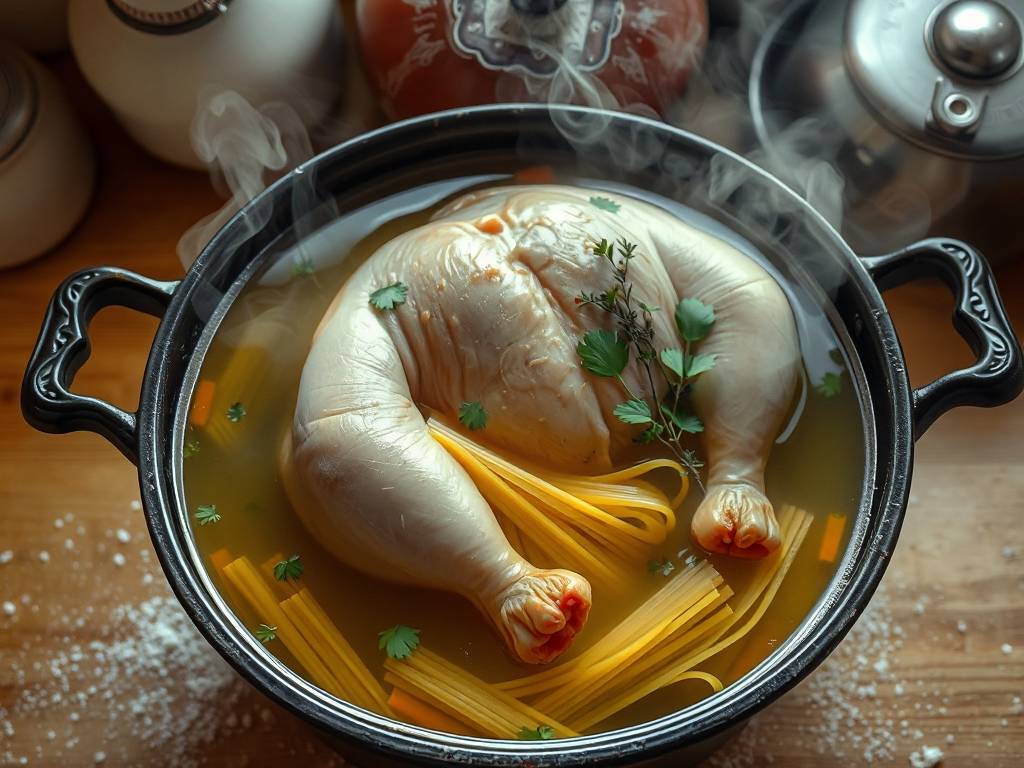The Ultimate Guide to Making Chicken Noodle Soup from Scratch
There's something profoundly comforting about a bowl of homemade chicken noodle soup. It's more than just food—it's a warm embrace on a cold day, a remedy for the soul when you're feeling under the weather, and a testament to the power of simple, wholesome ingredients. While store-bought versions offer convenience, nothing compares to the rich, complex flavors of a soup made completely from scratch. This comprehensive guide will walk you through creating the perfect chicken noodle soup, featuring a deeply flavorful homemade broth, tender poached chicken, and perfectly cooked noodles.
The Foundation: Crafting the Perfect Homemade Broth
The soul of any great chicken noodle soup lies in its broth. A well-made broth provides the foundation upon which all other elements build. For the richest flavor, I recommend using a combination of chicken parts—backs, necks, and wings are ideal as they contain plenty of collagen, which transforms into gelatin during cooking, giving the broth body and richness.
Begin by placing 3-4 pounds of chicken parts in a large stockpot. Add roughly chopped aromatics: two large onions (skin on for golden color), three carrots broken into large pieces, three celery stalks with leaves, and one head of garlic split horizontally. Don't peel the vegetables thoroughly—the skins and outer layers contribute depth and color to your broth. Add a tablespoon of whole black peppercorns, two bay leaves, and a small bunch of fresh thyme or parsley stems.

Cover everything with cold water—about 4-5 quarts—ensuring the ingredients are fully submerged. Slowly bring the pot to a gentle simmer over medium heat. This gradual heating allows proteins to dissolve slowly rather than coagulate quickly, resulting in a clearer broth. As the broth begins to heat, you'll notice foam rising to the surface. Skim this off carefully with a spoon or fine mesh skimmer—this step is crucial for achieving a clear, clean-tasting broth.
Once the broth reaches a simmer, reduce the heat to maintain the gentlest possible bubble—just a few bubbles breaking the surface occasionally. Partially cover the pot and let it cook for 4-6 hours. The extended cooking time is essential for extracting maximum flavor and nutrients from the bones and vegetables. If the liquid reduces too much, add more hot water to keep the ingredients covered.
After cooking, strain the broth through a fine-mesh sieve lined with cheesecloth. Press gently on the solids to extract all the flavorful liquid, but avoid squeezing too hard as this can make the broth cloudy. Let the broth cool slightly, then refrigerate until the fat solidifies on the surface for easy removal. What remains is a rich, gelatinous broth that forms the perfect base for your soup.
Preparing the Tender Chicken
While your broth is the flavor foundation, the chicken provides the heartiness and protein that makes this soup a complete meal. For the most tender results, I recommend poaching chicken thighs rather than using pre-cooked or roasted chicken. Thighs remain moist and flavorful even after extended cooking, unlike breast meat which can become dry and stringy.
Take 2 pounds of bone-in, skin-on chicken thighs and place them in a medium pot. Cover with your prepared broth (about 8 cups) and bring to a very gentle simmer over medium-low heat. Maintain this gentle cook—the broth should shimmer rather than bubble vigorously. Poach the thighs for 25-30 minutes until cooked through but still tender.
Remove the chicken from the broth and let it cool until manageable. Reserve the poaching liquid. Once cool enough to handle, remove the skin and bones, then shred the meat into bite-sized pieces using two forks or your fingers. The gentle poaching method ensures the chicken remains exceptionally moist and tender, ready to absorb the flavors of the finished soup.
Building the Soup Base
With your broth prepared and chicken shredded, it's time to build the soup layers. In your clean stockpot, heat two tablespoons of olive oil or chicken fat over medium heat. Add one finely diced large onion, two sliced carrots, and two sliced celery stalks. Sauté the vegetables until they begin to soften but haven't taken on color—about 8-10 minutes. This gentle cooking helps develop their natural sweetness without caramelization.
Add the reserved poaching broth (or your homemade broth) to the pot along with any accumulated juices from the shredded chicken. Bring the soup to a simmer and cook until the vegetables are tender but still have some bite—about 15-20 minutes. Season with salt and pepper to taste, remembering that the noodles will absorb some seasoning.
Now comes the critical decision: to add fresh herbs. I recommend a bouquet garni—a small bundle of fresh thyme, parsley stems, and a bay leaf tied with kitchen twine. This infuses the soup with herbal notes without leaving bits of herb in the final product. Remove the bouquet garni before serving.
The Noodle Component: Choosing and Cooking Perfectly
The noodles in chicken noodle soup might seem straightforward, but they deserve careful consideration. The type of noodle you choose significantly impacts the final result. Egg noodles are classic—their rich flavor and sturdy structure hold up well in broth. Alternatively, you might prefer wide flat noodles, small pasta like ditalini, or even homemade noodles for a special touch.
To prevent the noodles from becoming mushy and absorbing all your broth, cook them separately until just al dente. Bring a pot of well-salted water to a boil and cook your chosen noodles according to package directions, but reducing the cooking time by 1-2 minutes since they'll continue cooking slightly when added to the hot soup.
Drain the noodles thoroughly and rinse briefly with cool water to stop the cooking process and remove excess starch. This prevents the soup from becoming cloudy or gummy. Add the cooked noodles to the soup just before serving, along with the shredded chicken. This ensures the noodles maintain their perfect texture rather than becoming bloated and soft.
Bringing It All Together
The final assembly is where magic happens. Add the shredded chicken and cooked noodles to your simmering broth and vegetable mixture. Heat through for just 2-3 minutes—long enough to warm the additions without overcooking anything. Taste and adjust seasoning one last time, adding more salt or pepper if needed.

For a bright finish, stir in a tablespoon of fresh lemon juice and a handful of chopped fresh parsley right before serving. The acidity lifts all the flavors and cuts through the richness of the broth. Serve your chicken noodle soup piping hot in deep bowls, perhaps with a sprinkle of fresh dill or a grind of black pepper on top.
Storage and Reheating Tips
If you have leftovers (though this soup is so delicious you might not), store the soup and noodles separately if possible. The noodles will continue to absorb liquid, so when reheating, you may need to add a splash of water or additional broth to achieve the desired consistency.
The soup base without noodles will keep refrigerated for up to 4 days or frozen for up to 3 months. This makes it perfect for meal prep—simply cook fresh noodles when ready to serve for the best texture.
Customization Ideas
While traditional chicken noodle soup is perfect as is, you might enjoy experimenting with variations. Consider adding a parmesan rind to the broth for umami depth, a pinch of saffron threads for color and flavor, or a dash of hot sauce for spice. Vegetables like peas, corn, or spinach can be added in the last few minutes of cooking for additional color and nutrition.
For a heartier version, add diced potatoes or white beans. For an Asian-inspired twist, use rice noodles, add ginger and soy sauce to the broth, and garnish with cilantro and scallions. The basic technique remains the same—it's your canvas to create according to your preferences.
The Reward of Homemade
Making chicken noodle soup completely from scratch requires time and attention, but the results are immeasurably superior to any shortcut version. The depth of flavor in the broth, the perfect texture of the chicken, and the ideally cooked noodles create a symphony of comfort in every spoonful. This isn't just soup—it's nourishment for both body and spirit, a labor of love that rewards the cook and those who gather to enjoy it.
Next time you feel the need for comfort or want to care for someone under the weather, remember that the ultimate healing bowl starts with patience, quality ingredients, and these time-tested techniques. Your kitchen will fill with aromas that promise something truly special, and each spoonful will deliver on that promise.






发表评论